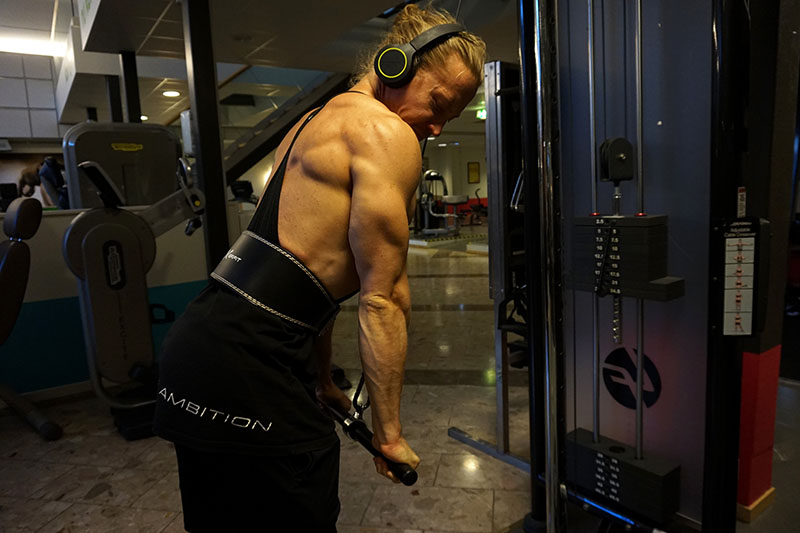
If you’re at all interested in muscle growth, I’m sure you’ve witnessed this debate:
On one side you have the camp who swears that strength training with low reps and high loads is the way to grow muscle.
And on the other side, you have the camp who swears that pump training with high reps and low loads is the way to grow muscle.
So, who’s actually right? What’s the optimal amount of reps for muscle growth?
Well, that’s exactly what we’re going to cover in this post.
But first, let’s first look at…
Table of Contents
What Makes Muscle Grow?
To find out whether strength training leads to the best growth, or if pumping your muscles is the way to go, let’s first identify the mechanisms that promotes muscle growth.
In 2010 Brad Schoenfeld published a paper explaining the three causes of muscle growth
And they are:
- Mechanical tension – Tension on your muscles caused by lifting heavy weights (aka strength training)
- Muscle damage – how much you break the muscle fibers during training
- Metabolic fatigue – the burn you feel when doing high reps, with light weights (aka pump training)
Now, in more recent years it’s been shown that muscle damage doesn’t play as big of a role for muscle growth as the other two, and the little role it plays can be achieved in all rep ranges anyways.
So, for simplicity, let’s leave it out.
What remains then are the two major mechanism of muscle growth:
Mechanical tension and Metabolic fatigue.
So, the question becomes:
Which one wins?
The Answer: Nobody Wins!
It turns out that you can get pretty much identical muscle growth training in all rep ranges.
In fact, powerlifter, writer and coach Greg Nuckols created a fantastic article covering all the research comparing different rep ranges.
And here’s his conclusion:
 I think instead of asking yourself, “Is this rep range better than this other rep range in some objective physiological sense?” you’re better off asking yourself, “What allows me to get in the most high quality sets during each session and during each week?”
I think instead of asking yourself, “Is this rep range better than this other rep range in some objective physiological sense?” you’re better off asking yourself, “What allows me to get in the most high quality sets during each session and during each week?”
So, whether you choose strength training or pump training, just know that you can grow very well doing either one of them.
Now, with that said, and as Greg also mentions, when it comes down to doing the actual work, it becomes a different story.
Let me explain:
Use The Rep Range That Gives You The Most Bang For Your Buck
When it comes to training (and dieting):
I believe that your goal should always be to get the best results possible with the least effort and hussle required.
In fact, that’s exactly what Iron Built Fitness is all about, and the reason I go with this slogan on my YouTube channel:

I mean, isn’t that what most of us want? To get great results from as little work as possible?
At least that’s what I’m going for!
And here’s the good news:
There’s one rep range that will cause maximum growth with the least amount of effort.
And that is:
The Medium Rep Range
We can categorize pretty accurately three different rep ranges where the work you do causes different amounts of mechanical tension or metabolic fatigue.
And my definition of these ranges are as follows:
- The low rep range: 1-4 reps
- The medium rep range: 5-12 reps
- The high rep range: 12+ reps
In the low rep range (1-4 reps) you will predominantly cause mechanical tension.
In the high rep range (12+ reps) you will predominantly cause metabolic fatigue.
In the medium rep range (5-12 reps) you will cause a mixture of both.
And the fact that the medium rep range causes a mixture of both, is what makes it so powerful.
Let’s look at why:
Optimal Muscle Fiber Recruitment
You’ve probably heard about muscle fibers at some point, right?
But, just briefly; muscle fibers are what our muscles are made up of.
And these fibers are the tissue that allows us to contract and relax our muscles.
Basically, we have 2 different types of muscle fibers:
- Slow-twitch fibers – Which are characterized by low force, power and speed production but have a high endurance threshold. These also have the least potential for growth
- Fast-twitch fibers – Which are characterized by high force, power and speed production but instead have a low endurance threshold. These also have the most potential for growth
Now, as you can see, if you want bigger muscles, you should focus most of your energy on developing your fast-twitch muscle fibers, as these are the ones with the highest potential for growth.
But, that’s not enough to maximize your muscle growth.
To do so you need to develop your slow-twitch fibers as well.
Even though they won’t grow as large as fast-twitch fibers, they will still help with your overall muscular development and appearance.
Because here’s the thing:
This essentially means that if you’re not training all your fibers, you won’t get complete development.
So, training in a way that allows you target all your muscle fibers, in the most effective way possible, is a smart thing to do.
And that’s exactly what the 5-12 rep range will help you do.
Here’s why:
You Train With Weights That Are Heavy Enough to Cause Growth Immediately
Muscle fibers are recruited in an order according to something called the size principle.
This principle essentially tells us that slow-twitch muscle fibers (with the least potential for growth) is going to be activated before fast-twitch muscle fibers (with the highest potential for growth)
Just like this:
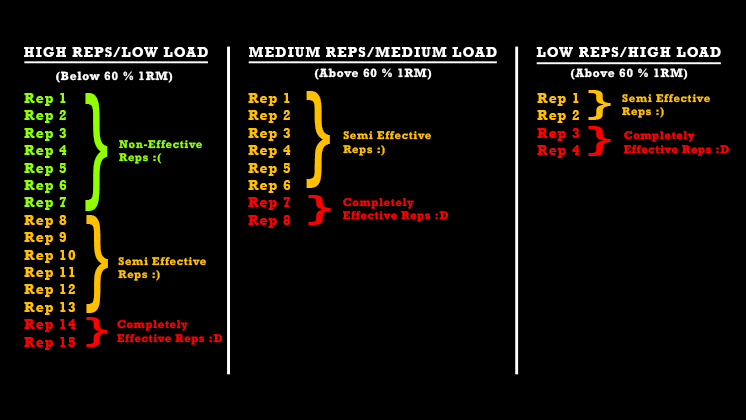
As you can see, in order to start recruiting type 2 muscle fibers (with the highest potential for growth) immediately, you must lift above a certain threshold of intensity.
And this threshold is passed when the weights you use are higher than 60 % of your 1 repetition max.
This is accomplished by lifting in the medium to heavy rep range.
On the other hand, if you train with high repetitions and light loads, you’ll still be able to recruit your type 2 fibers, and create a good stimulus for growth.
But…
They won’t be recruited until you reach the very last few reps of your set
In fact, research has shown that:
In order to recruit your type 2 fibers maximally when training in the higher rep ranges, you need to go to the point of absolute failure, where fatigued is so high that you no longer can perform the lift.
And this is where the effectiveness of high rep training goes out the window.
For a couple of reasons:
1. Unproportional relationship between fatigue and muscle growth
Look:
When training with high reps and low loads all the way to failure, you must go through all the non-effective reps before you start to really build muscle.
And this leads you to do more total work for the same amount of gains.
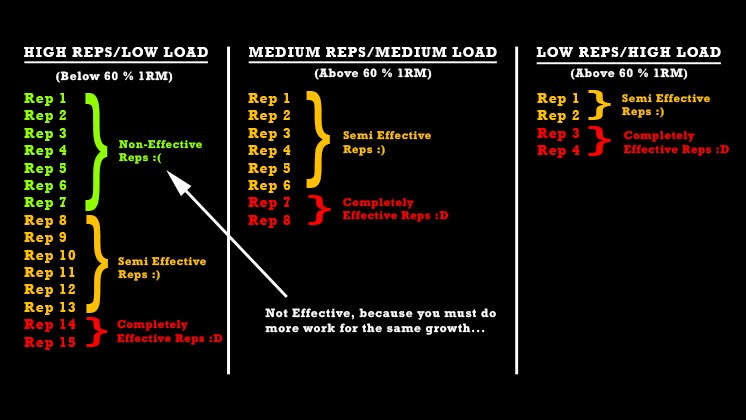
Not only does this take up more of your time, but it also steals a bit from your recovery.
This is because you must go through a lot of “junk volume” to reach maximum stimulus for growth.
And this can reduce your ability to perform training volume slighly. Which has been shown repeatedly to be the main driver of muscle growth.
2. It’s freakin’ painful
I think that anyone who’s tried doing 15-30 reps all the way to failure, over and over again, know just how painful that is.
As a matter of fact:
In some of the studies made on low load, high rep training to failure, the participants actually threw up from doing the work required to maximize muscle growth at such low intensities.
And on that note, I just have to share Lyle McDonald’s conclusion of low rep training for muscle growth, because I think it’s hilarious:
 “You do three times the work at about 10 times the pain level for the same amount of end result growth. And you don’t look macho fooling around with light weights and we all know that getting attention in the gym is the key to greatness.”
“You do three times the work at about 10 times the pain level for the same amount of end result growth. And you don’t look macho fooling around with light weights and we all know that getting attention in the gym is the key to greatness.”
The only time that I’ve found high repetitions to be effective is when using it in combination with rest-pause techniques, such as Myo reps. This is a strategy where you’re taking advantage of short rest periods to get complete muscle fiber recruitment from the very first repetition. This is especially beneficial for assistance exercises.
Alright, so other than with the use of Myo reps, the high rep range are out of the window when it comes to effectiveness, but what about the low rep range?
Working in the low rep range must be optimal for muscle growth since the weight is immediately heavy enough?
Well, kinda… But the medium rep range is still better.
And here’s why:
You Must Reach a Certain Level of Training Volume to Maximize Growth
Remember that in order to maximize muscle growth, it doesn’t all come down to high mechanical tension on the muscle fibers.
No, muscle damage and especially metabolic fatigue also plays a big role for growth.
This essentially means that to maximize muscle growth you also need a certain time under tension to create muscle damage and a certain amount of reps to fatigue all the muscle fibers.
In other words:
You need to do enough training volume.
So, now you might think:
“Okay, so I can just do more sets in a low rep range and I’ll automatically achieve higher training volumes?”
And yes, that’s correct!
But, training in the medium rep range would still be better.
Because of this finding:
In another study conducted by Brad Schoenfeld, they had participants doing the same amount of volume with two different loads:
One group did 7 sets of 3 reps, and another group did 3 sets of 10 reps.
These are both loads that’s above 60 % of 1 rep max and are heavy enough to cause growth immediately.
By the end of the study period, both groups achieved the same amount of muscle growth.
But, here’s the deal:
The work the both groups had to do was very different!
The group doing 3 reps had to do more than double the sets compared to the group doing 10 reps, just to get the same amount of growth.
Doing such a high amount of sets, with weights close to max, must be tough…
And guess what, that was shown in the study as well:
Most of the participants in the high load group doing 7 sets of 3 reported feelings of high exhaustion, daily fatigue, and some of the guys even got injured and had to drop out.
On the other hand, the guys doing 3 sets of 10 reported feeling energized and wanted to do more.
Their workout only took about 20 minutes, compared to the other group who stayed in the gym for more than an hour.
So, here’s what we get from this:
Even though you can get maximal growth with low reps, it’s probably not worth it.
Because just as with the case of low load training you would have to do more total work to get the same results:
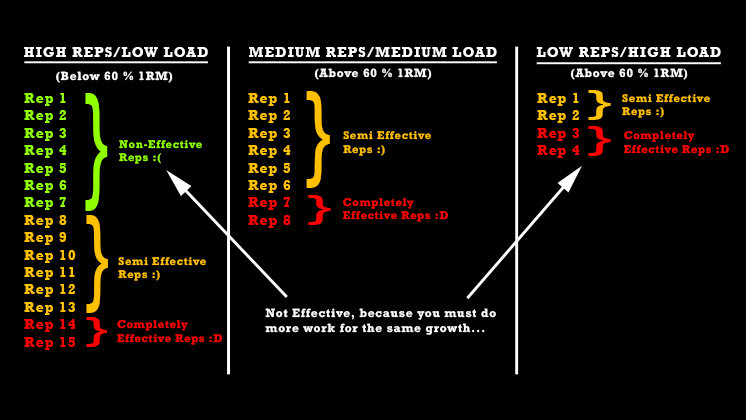
With this said though, there’s one training strategy in particular where I think training with high reps is definitely worth it, and that’s Myo reps. This is a very effective rest-pause strategy where you’re utilizing short rest times to get an incredible stimulus in around one third of the time it would take you using straight sets.
If you want to learn more about Myo reps, then I recommend checking out this post next.
The Medium Rep Range Is The Way to Train (most of the time)
If you decide to workout in the 5-10 rep range (even up to 12 reps), here’s what would happen:
In other words, and to quote Dr. Eric Helms:
 “Training in a medium rep range is the most effective and efficient way to accumulate volume with a heavy enough weight.”
“Training in a medium rep range is the most effective and efficient way to accumulate volume with a heavy enough weight.”
Now, with all of this said, it’s likely going to be beneficial to do some training in both the low and high rep ranges as well.
Include Some Low And High Rep Training As Well to Maximize Growth
At the end of the day, all rep ranges causes a rather similar amount of muscle growth, which means that you can choose whether you want to train for strength or the pump.
What’s more important than the rep range, is that you train with enough volume and make sure that you progressively overload your workouts overtime. And this is most effectively done in the medium rep range.
But with that said, some research shows that using a variety of rep ranges and training loads causes more growth than just sticking with one.
This seems to be because heavier loads might cause slightly more growth of type 2 muscle fibers, while lighter loads might cause slightly more growth in type 1 muscle fibers.
However, this is a bit murky and more research needs to be conducted before we can know for sure.
My Recommendations
To maximize muscle growth, with the least amount of effort required, here’s what I would recommend that you do:
- 80 % of your training in the medium rep range (between 5-12 repetitions)
- 10 % in the low rep range (between 1-4 repetitions)
- 10 % in the high rep range (with higher than 12 repetitions)
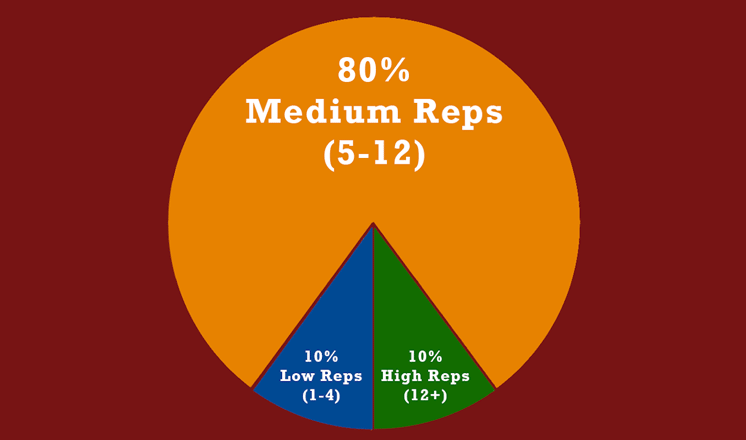
Conclusion – How Many Reps For Muscle Growth?
For muscle growth it’s becoming more and more clear that you can grow very well in all rep ranges.
The medium rep range (5-12) seems to be the most effective and efficient rep range to use.
Simply because you accumulate the most tension, fatigue and muscle damage in the shortest amount of time.
To maximize muscle growth, I recommend that you do most of your training in the medium rep range and focus on strength. But also do some of your work in both the low and high ranges as well.
What’s next?
Okay, so training in the medium rep range (5-12 reps) is the most effective way to grow muscle. But, in order for it to be effective at all, you must first make sure that you train for something called progressive overload. Learn how by reading this post!
